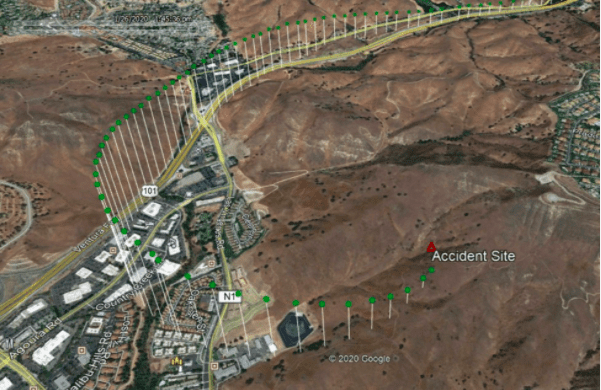
This photo illustration is from radar tracking the last minute of the flight path of the Sikorsky S-76B helicopter. Google Earth image, NTSB graphic overlay by Bill English. (NTSB)
The National Transportation Safety Board (NTSB) concluded that the fatal Sikorsky S-76B helicopter crash in Calabasas, California on Jan. 26, 2020, was caused by the pilot’s decision to continue flying in adverse weather conditions without proper flight instruments resulting in disorientation and loss of control of the aircraft, according to a Feb. 9 press release from the NTSB. The crash resulted in the death of the pilot and eight passengers on board including basketball player Kobe Bryant.
The pilot was conducting the flight under visual flight rules in which the pilot flies by reference visuals, in instrument meteorological conditions (IMC) where pilots are required to fly by instrument references, according to NTSB. The NTSB also cites the pilot’s likely self-induced pressure and plan continuation bias as a cause for the crash.
“Unfortunately, we continue to see these same issues influence poor decision making among otherwise experienced pilots in aviation crashes,” NTSB Chairman Robert Sumwalt, said in a press statement. “Had this pilot not succumbed to the pressures he placed on himself to continue the flight into adverse weather, it is likely this accident would not have happened. A robust safety management system can help operators like Island Express provide the support their pilots need to help them resist such very real pressures.”
The crash happened when the pilot was attempting to fly the helicopter out of a poor visibility area. NTSB said the aircraft was at an altitude of 450 feet above ground level two minutes before the crash when the pilot told an air traffic control facility he was initiating a climb. The helicopter then began to climb 1,500 feet per minute while making a left turn and made it to an altitude of about 2,400 feet before descending rapidly and crashing.
NTSB concluded that Island Express Helicopters Inc., who operated the aircraft, had an inadequate safety management process which also contributed to the crash. This conclusion was based on a lack of documented policy and safety assurance evaluations to ensure pilots were correctly completing flight risk analysis forms.
The report makes four recommendations, two to the Federal Aviation Administration (FAA) and two to Island Express Helicopters Inc., based on NTSB’s investigation.
NTSB recommends the FAA require simulation devices during pilot training for Part 135 helicopter operations to address responses to changing weather conditions and convene a multidisciplinary panel of aircraft performance, human factors, and aircraft operations specialists to evaluate spatial disorientation simulation technologies. The recommendations for Island Express Helicopters Inc. include its participation in the FAA’s Safety Management System Voluntary Program and installing flight data recording devices on all helicopters.